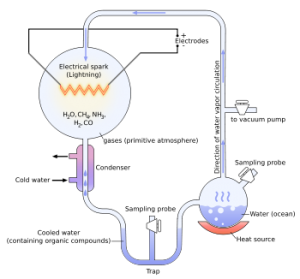The Cradle of Life: Deep Sea Alkaline Vents
The famous Urey-Miller experiment from the 1950s has been taught in high school science class as an example of how life might have begun. The idea of life beginning in what Darwin called a “warm little pond” had been around even before Darwin’s time. The Urey-Miller experiment captured the attention of everyone, because Stanley Miller managed to create a number of complex amino acids in his electrically charged mixture.
No Soup For You
In half century since the Urey-Miller experiment we have come to know a lot more about the conditions of the early earth some 4 billion years ago. And we have come to know so much more about DNA, the biological cell, and the chemical reactions that go into the metabolism of living organisms. Although the famous experiment is often still depicted in high school science textbooks, the scientific community itself has long since realized that life arising from non-life is not that simple. In fact, the critics of evolution who say that the probability of life arising by random chance from a primordial soup is astronomically small are completely correct (but only if you assume a process of pure random chance. See article, Fred Hoyle’s Junkyard Fallacy).
What is missing from the equation is the metabolic processes that life uses to obtain energy and build the complex molecules that are the moving parts of organic cells. So for many decades now, the Miller-Urey experiment has been placed in the backroom of science on the shelf labeled “very interesting”, but it no longer represents the scientific consensus of speculation that life arose from a primordial soup charged with lightning. (See the article, Life’s Origin: No Soup For You)
Est Machina, Stolidi (It’s the machine, stupid)
So the problem of having the right chemistry in one place to create life is a simple one, and one that is very well understood. The bigger problem is figuring out what kind of pre-organic “machinery” could have been found in one place on the ancient Earth to drive the complex chemistry before there was an independent organic entity that had its own metabolism. You see, most of the chemical reactions in organic life will not proceed on their own by just having the chemicals sloshing around near each other. Stanley Miller’s spark gap was a good first attempt at supplying some kind of kick for promoting the reactions, but it is far too simple to drive most of the metabolic reactions.
For example, the most basic energy source for all of organic life is Hydrogen reacting with Carbon Dioxide. This is no surprise because Hydrogen from water and the CO2 rich atmosphere (and oceans) are some of the most abundant chemicals on the planet. There is energy to be had in reacting those two chemicals and each time that happens, the planet moves closer to thermodynamic equilibrium (because the stored energy is released). So in a sense, life is the planet’s answer to the problem of lots of H2 and CO2 in disequilibrium.
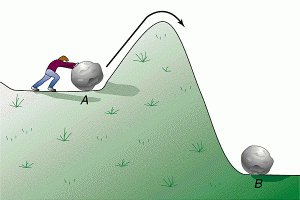
Some chemical reactions need a “push” in the form of some activation energy. But many such reactions will release more energy than was in the “push”.
But due to the shape of the CO2 molecule, the reaction needs a “driver” that adds a little push to the reaction before it occurs. Once that push is supplied, the reaction occurs and releases lots more energy than push supplied along with a number of other chemical products such as methane and acetic acid. The energy in the push is called the “activation energy” and many chemical reactions require some amount of it to drive them, even if the end result is much more energy coming out of the reaction than you needed to put into it.
It is important to realize that this push in the form of activation energy is not like lighting a fire, where once you supply the initial spark the rest will proceed on its own. Each H2 and CO2 molecule require their own push to get them to react together. So you can see that if all of organic life burns H2 and CO2, it has to have metabolic machinery running all the time to keep those reactions going.
The same goes for many of the more complex metabolic reactions, such as the production of enzymes. Many of these reactions occur in living organisms through the use of metal catalysts such as tungsten and molybdenum which serve to lower the required activation energy.
Then there is the sequencing machinery driven by DNA that puts together amino acids which drive the production of complex proteins that make up the bulk of organic matter. This can be called sequencing machinery because the proteins have to be assembled by a precise sequence of reactions that happen with the right timing. And finally, the cell itself, that contains and protects all the DNA and the complex metabolic machinery from certain rapid decomposition if exposed to the raw elements of the environment.
A Cell Called LUCA
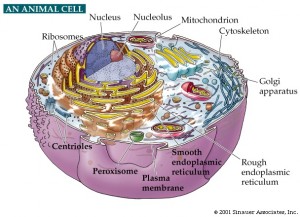 Although we still have a lot to learn, it is no mystery where the next cell is going to come from in the world. It comes through an existing cell being replicated to produce another one, whether it is a single celled organism or a cell in the human body. Cells are the “legos” of organic life all across the spectrum of living organisms. And each cell in the world has come from one before it, in an unbroken chain that goes back almost 4 billion years to one particular individual that we call LUCA, which stands for Last Common Universal Ancestor. LUCA was not the only cell in the world at that time, but it is the one whose ancestors makes up all of life on Earth today. There might have been billions of other potential LUCAs, but only one line survives today.
Although we still have a lot to learn, it is no mystery where the next cell is going to come from in the world. It comes through an existing cell being replicated to produce another one, whether it is a single celled organism or a cell in the human body. Cells are the “legos” of organic life all across the spectrum of living organisms. And each cell in the world has come from one before it, in an unbroken chain that goes back almost 4 billion years to one particular individual that we call LUCA, which stands for Last Common Universal Ancestor. LUCA was not the only cell in the world at that time, but it is the one whose ancestors makes up all of life on Earth today. There might have been billions of other potential LUCAs, but only one line survives today.
Using modern techniques for analyzing the genes of many living organisms and comparing them, we are able to trace the tree of life back to a bacterial LUCA somewhere between three and four billion years ago. And we can identify some bacteria alive today that have been pretty much unchanged for almost 4 billion years.
At that point, we hit a kind of information barrier that is somewhat cloudy. The reason is that the DNA sequencing techniques that we use to build the tree of life over deep time can only take us back to the earliest DNA bearing LUCA. And that organism was already a complete self contained cell with cell walls, DNA, and complex metabolic machinery. It already knew how to burn hydrogen and carbon dioxide and build up the complex amino acids and proteins that made up its internal metabolism. LUCA was self-sustaining and able to replicate itself like any bacteria we can find today. So from LUCA forward, we understand where all of life came from.
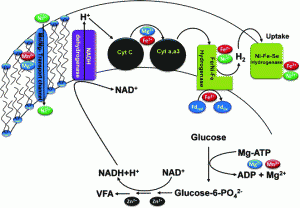 Although we always have more to learn, we do understand how organic cells push reactions over the activation energy barrier. The hydrogen and carbon dioxide problem is solved by an ingenious proton pump that is more physics than it is chemistry. Other reactions make use of metallic catalysts, such as iron, manganese, molybdenum and tungsten. And the complex amino acids and proteins are put together piece by piece by DNA driven machinery with careful sequencing and timing.
Although we always have more to learn, we do understand how organic cells push reactions over the activation energy barrier. The hydrogen and carbon dioxide problem is solved by an ingenious proton pump that is more physics than it is chemistry. Other reactions make use of metallic catalysts, such as iron, manganese, molybdenum and tungsten. And the complex amino acids and proteins are put together piece by piece by DNA driven machinery with careful sequencing and timing.
Knowing that it takes DNA driven metabolic machinery inside cells to sustain life and make more life, and knowing that the necessary chemical reactions won’t just happen on their own in a warm pond, it would seem that the organic cell is something that is irreducibly complex. I say, “irreducibly” since it would seem that there is nothing major one could remove and still have it work. It takes a cell and its DNA to make another cell and run the metabolism to sustain it, and it takes the protection of the cell and the internal metabolism for DNA to do its work. It is a kind of chicken/egg” problem.
Life Before LUCA
The challenge facing abiogenesis researchers is one of figuring out how any of the separate pieces of machinery in LUCA could have come about on their own since they all seem dependent on each other. This takes us very far afield from the warm little pond to some very special place on Earth some 4 billion years ago where separate pieces of this machinery could be found in inorganic process that came together to jump-start LUCA and all its long lost cousins.
As I said before, we already know how life since LUCA has managed to build such amazing complexity and diversity form that humble little bacteria cell. It relies on the simple but extremely powerful process that takes place when life replicates itself to form a new organisms. The process of variation, selection, and inheritance, which forms the basic processes of evolution at work over many generations is responsible for that. Therefore, there is no reason to not pursue the hypothesis that some form of similar processes were working in the systems that gave rise to LUCA. The key to that is self-replication, of course, and the abiogenesis research seeks to push the hypothesis of self-replication and selection as far back in time before LUCA as possible, until we are at the point where what is left is finding a suitable venue for the simpler reactions to be driven by forces that can be found in the surrounding environment.
If LUCA represents the first ancestor of what we could call our modern DNA world, it seems as if an RNA world is what immediately preceded the DNA world. this hypothesis has single cell organisms that use RNA to house the instructions to operate its metabolic machinery and to replicate itself during the production of new cells. At first this doesn’t seem to answer the question of where DNA came from since in life since LUCA, it is DNA that produces RNA to carry its information into the machinery of the cell. RNA is a messenger rather than a creator. On the other hand, there is good reason to suspect that RNA can give rise to DNA.
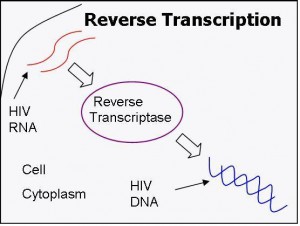 This is not a difficult speculation because we already can observe viruses, which are little packages of protected RNA, invade cells, hijack the cell’s machinery to turn its RNA into DNA, which then replicates to create new virus RNA in a process called Reverse Transcription. Such viruses are called Retroviruses because the manage to run the DNA to RNA process backwards. The most famous of this is the HIV retrovirus. Also, we see that biological cells contain what appears to be the fossil of a previous independent organism that used RNA as its genetic material. It appears that at some point an invading RNA based organism that we call mitochondria became part of the internal machinery of modern cells.
This is not a difficult speculation because we already can observe viruses, which are little packages of protected RNA, invade cells, hijack the cell’s machinery to turn its RNA into DNA, which then replicates to create new virus RNA in a process called Reverse Transcription. Such viruses are called Retroviruses because the manage to run the DNA to RNA process backwards. The most famous of this is the HIV retrovirus. Also, we see that biological cells contain what appears to be the fossil of a previous independent organism that used RNA as its genetic material. It appears that at some point an invading RNA based organism that we call mitochondria became part of the internal machinery of modern cells.
So it is not a big stretch to push our boundary of irreducible complexity back into the RNA world a ways and still postulate an unbroken succession of cells with a complex metabolism which can support replicating to create more cells.
 So in summary, the big puzzle to solve for those in the abiogenesis research businesses is this “chicken or egg” problem of the apparent irreducible complexity of cells, RNA, DNA, and metabolism. Cells come from other cells, and need DNA to drive that replication and the internal metabolic processes. And DNA needs the cells and the machinery in the cells in order to carry out its instructions. It seems as if none of the parts could simply come about on their own and thrive without the aid of the other parts. So the complexity of cells seems “irreducible” in that you can’t reduce a cell by any of its major parts and expect it to thrive. So how could the components have come about one at a time without the aid of the other ones.
So in summary, the big puzzle to solve for those in the abiogenesis research businesses is this “chicken or egg” problem of the apparent irreducible complexity of cells, RNA, DNA, and metabolism. Cells come from other cells, and need DNA to drive that replication and the internal metabolic processes. And DNA needs the cells and the machinery in the cells in order to carry out its instructions. It seems as if none of the parts could simply come about on their own and thrive without the aid of the other parts. So the complexity of cells seems “irreducible” in that you can’t reduce a cell by any of its major parts and expect it to thrive. So how could the components have come about one at a time without the aid of the other ones.
A simple example of something irreducibly complex is a masonry arch. Consider that one cannot remove a single block from a masonry arch without it falling down. And if we didn’t already know how it was constructed, we would conclude that it was impossible to construct block by block because all the blocks are required for it to stay together without falling.
It so happens we know how masonry arches are built. Masons erect supporting scaffolding under the span to hold the incomplete archway in place. When the archway is complete, they remove the scaffolding. We know that masons are clever so we are not surprised that they invented scaffolding thousands of years ago. The question arises, then, can nature devise a scaffold as well? And so it can. Consider the figure at the right, where wind has carved out the area beneath a stone arch.
An example in biology is the Bolas Spider. The bolas spider mastophora uses an unusual prey-capture system. It spins only a single short strand of web, at the end of which is a drop of glue. Then it swings this strand around in circle underneath it. At the same time, it releases a scent – a pheromone – that attracts male Noctuid moths. A moth flies into the area, hits the glue, and sticks. The spider draws in the trapped moth and dines.
This system would seem to be irreducibly complex. Without the glue, the moth wouldn’t get trapped. Without the web, moths that fly by (as opposed to landing by the spider) wouldn’t get caught. Without the pheromone, there wouldn’t be enough moths in the area. The web swinging behavior is reducible, though. There is a cave-dwelling fly larva which attracts prey with a light, instead of a smell. It has a single-strand web, but doesn’t swing it.
The bolas spider’s system could have evolved gradually. Imagine a spider with a normal sticky web. Add the pheromone. Lots of moths get caught, so there’s no point in wasting effort on a great big web with lots of glue. The web is gradually simplified all the way down to one strand with one dot of glue. But the pheromone, which was just an improvement, gradually becomes a necessity. So the original spider web is the scaffold that works on its own the pheremone makes most of it superfluous. Over time, the cost in time and energy of building the entire web is something that gets “evolved out” (such as tails on the hominds that led to humans) and disappears.
Scaffolding and the Lost City
If scaffolding is a key to the creation of what appears to be irreducibly complex cells, finding an ancient environment that had enough scaffolding was really taxing our speculative abilities until we happened upon a very unusual place on Earth. This place was incredibly rich in the ingredients, the abundant energy, and the inorganic machinery that could create all the moving parts we are looking for as somewhat separate pieces. Having already been amazed at finding life in the extremely hostile and alien environment around the deep-sea thermal vents, we discovered a different form of thermal vents that were no so dramatically alien. These are called alkaline vents of the type found in the area under the Atlantic that is now called Lost City.
These unique deep sea formations are (or were) rich in the geology, energy, inorganic chemistry and physics that formed an environment rich in the scaffolding processes that we have been searching for.
This article is still under construction. It has been made public to allow critical review.
http://www.nick-lane.net/LAM%20BioEssays.pdf
http://www.ploscompbiol.org/article/info:doi/10.1371/journal.pcbi.1002455
http://www.genomenewsnetwork.org/articles/04_03/minimal.shtml
http://www.accessexcellence.org/WN/NM/miller.php
http://rstb.royalsocietypublishing.org/content/361/1470/969.full
http://rstb.royalsocietypublishing.org/content/362/1486/1887.long
Category: 15 Questions for Evolutionists, Defending Evolution, How Did Life Originate, The Big Questions

